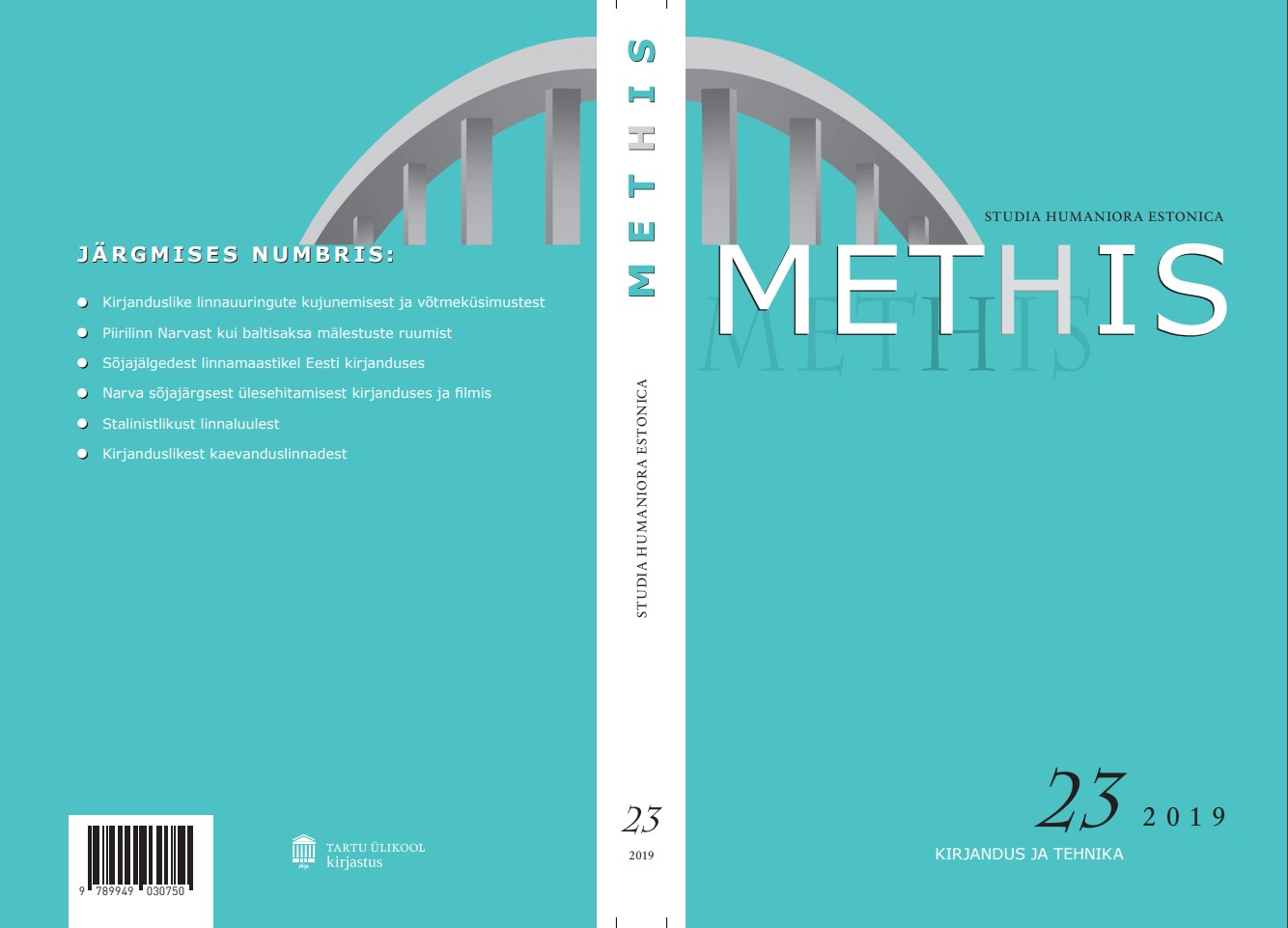„Muutume masinateks“. Tehnoloogia ja soolistatud kehad ameerika modernismis / “We Twiddle … and Turn into Machines”: Technology and gendered bodies in American modernism
DOI:
https://doi.org/10.7592/methis.v18i23.14799Keywords:
modernism, naismodernistid, sooline kriis, dadaism, Mina Loy, Modernism, female modernists, gender crisis, DadaismAbstract
Käesoleva artikli eesmärgiks on analüüsida, kuidas tehnoloogilised kuvandid sobituvad modernsuse perioodi laiemasse soolistatud kriisidiskursusesse. Palju on kirjutatud modernsusega seotud tajukriisist ja selle seotusest tehnoloogiaga, kuid vähem on uuritud seda, kuidas tajukriisi saab sobitada samal ajal domineerinud tajutud soolise kriisiga, eelkõige mehelikkuse kriisiga. Kuna paljud modernsuse kehalised, tajumuslikud ja esteetilised otsingud olid soolistatud, siis on viljakas küsida, kuidas soolistas modernism masinat ning kuidas mängisid selle soolistatud masinavärgiga modernsed naisautorid. Naisautoritele oli meesautoritest olulisem – või ka paratamatum – kirjutamine kehast lähtuvalt või kehast distantseerudes ning masinaesteetika on neile mitmest perspektiivist atraktiivne võimalus kirjutamise käigus vabaneda naistele omistatavast kehalisest ja immanentsest bioloogilisest paratamatusest. Käesolevas artiklis kasutatakse kirjandusnäiteid futurismi ja dadaismiga seotud inglise-ameerika naisluuletajalt Mina Loylt, kuid eesmärgiks pole niivõrd tema tekstide lähilugemine kui laiem arutelu masinaloogika ja soodiskursuste ristumise üle modernismi kontekstis.
The present article sets out to explore how technological imagery interacts with the gendered crisis discourses prevalent in the period of modernity. Much has been written about the crises of perception and their associations with technology, but much less attention has been given to how they intersect with the perceived gender crisis, especially the crisis of masculinity dominant at the time. On the one hand, modernity celebrated the machine and sought to make male bodies into machines. Henry Ford was one of the lauded gods of the era and bodybuilding seemed to offer a way of treating the human body as a similar, sleek and controlled machine. On the other hand, although technology was engendered by male-centered society, it also seemed to be eating its sons, as it eroded male autonomy and rendered him into a mere cog in the machine. This creates a contradictory set of gendered images in which modernity is frequently associated with emasculation, especially when we consider the fact that the period also saw the assertive entry of women onto the public arena, as voters, creators and also consumers. The often openly violent radicalism of the new women posed a challenge to the male modernists who were seeking to achieve a revolution in perception but whose pursuits were confined to the pages of literary magazines. This creates a love-hate relationship between Anglo-American male modernists and feminism, as has been previously demonstrated by Marianne DeKoeven, Rachel Blau DuPlessis, and others. One way of resolving this tension is by rendering the woman machine-sleek, yet non-threatening, a technologically updated cyborg to fit the modern Pygmalion. This cyborg, as texts such as Fritz Lang’s Metropolis show, was nevertheless unsettling in its potential uncontrollability. It is this gendered ambivalence that the present article focuses on to ask whether the woman is just a cog in the wheel of modernism or whether she can also act as a spanner in the system.
Specifically, the article asks how modernity gendered the machine and how women writers manipulated this gendered machine imagery. Women more than men had to write through or against the body and thus machine aesthetic was attractive to them as a means of writing themselves free from the bodily immanence traditionally attributed to women. The article builds on the work of Tim Armstrong (1998), Sara Danius (2002), Amelia Jones (2004), and Alex Goody (2007). The examples have been borrowed from the work of Anglo-American poet Mina Loy, but the aim is not a close reading of her literary texts, but the discussion of the intersection of machine logic and gender discourses in the context of modernism and modernity more broadly. Loy is placed into the Dadaist milieu where gender play was a widespread artistic tool for male and female artists (Marchel Duchamp, but also the much more marginal Elsa von Freytag-Lohringhoven). Loy, a major minor writer, was broadly celebrated in her day as an embodiment of modernity, somebody whose life was as important as her writing. Forgotten for decades, Loy has emerged again in literary scholarship owing to her frank representation of female body and sexuality. The present article, however, is less interested in her engagement with embodiment, but rather tackles her struggle in the field of tension between the impersonal aesthetics of high modernism and the need to write female subjectivity. This is where the use of machine imagery offers a creative solution. However, Loy’s machines do not copy those of Marinetti and other futurists whom Loy openly satirizes in her writing. She does not make the human body a machine prosthetic. Loy’s machines are organic, vulnerable and leaky.
The article concludes that while male avant-garde writers projected their fear of the machine to the female body, the women writers are able to render the machine that does not work into a subversive critique of techno-reality that is defined from a narrowly male-centered perspective. This critique is the more subversive because it is presented in the impersonal language of male-centered high modernism. The woman modernist is both an ally and an enemy: she is mechanized as a part of the new technological culture but her physical body, with its leakiness and porousness, also breaks the rigid boundaries of machine aesthetics and perhaps also binary modes of perception.


